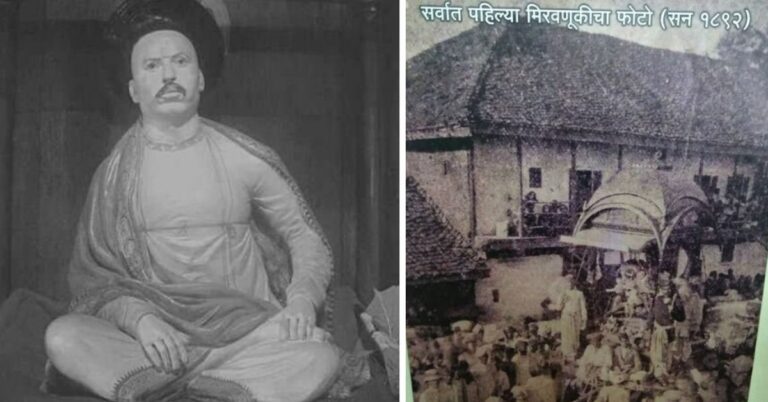Every year, as households across India come alive with festive lights, flowers, and the joyous call of “Ganapati Bappa Morya!”, millions celebrate Ganeshotsav, a festival that has transcended religious boundaries and emerged as a symbol of unity. But the roots of this grand public celebration go back more than 130 years to a time when India was in the throes of a freedom struggle against British colonial rule. Behind this iconic festival lies the story of a visionary royal physician and freedom fighter: Shrimant Bhausaheb Rangari.
The Birth of Ganeshotsav as a Public Festival
In the late 19th century, India was a land divided by regional, cultural, and religious differences, while the colonial British rule sought to suppress any form of national unity. Amid this political climate, a spark of inspiration struck Pune resident Krishnajipant Khasgiwale during his visit to Gwalior in 1892, where he witnessed a public celebration of Lord Ganesha. Khasgiwale, impressed by the sense of community the festival fostered, returned home with a vision: to use the Ganesh festival as a tool to unite Indians in their resistance against British oppression.
Khasgiwale shared his thoughts with Shrimant Bhausaheb Rangari, a well-known royal physician and patriot, and Balasaheb Natu. Inspired by the idea, Rangari took it upon himself to bring this vision to life in Pune.
Shrimant Bhausaheb Rangari: A Physician and Patriot
Shrimant Bhausaheb Rangari was no ordinary man. Apart from being a respected royal physician, he was deeply involved in India’s freedom struggle, using his position and influence to fight against the colonial powers. Rangari saw in the Ganesh festival a powerful symbol that could unite people across social and religious lines, turning a religious event into a political statement against the British.
In 1892, Bhausaheb Rangari made history by installing the first-ever saarvajanik (public) Ganesha idol at his home in Shalukar Bol, Pune. This event marked the beginning of Ganeshotsav as a public celebration, a tradition that would grow into a massive movement over the years.
The Iconic Ganesha Idol: Symbolism of Freedom
What set Rangari’s idol apart was its striking departure from the typical peaceful and composed representations of Lord Ganesha. His idol depicted the deity in a fierce avatar, slaying a demon — a clear metaphor for India’s battle against the British colonizers. The idol was made of wood and bran, representing not just divine power but also the grit and determination of the people to overcome their oppressors.
The message was subtle but clear: India, like Lord Ganesha, was fighting its own demon in the form of colonial rule. Rangari’s vision was to use this imagery to awaken the spirit of resistance among Indians.
Lokmanya Tilak’s Role: Amplifying the Movement
While Bhausaheb Rangari’s initiative garnered local attention, it gained national prominence when Lokmanya Bal Gangadhar Tilak, a prominent leader in the freedom struggle, recognized its potential. Tilak praised Rangari’s efforts in an article in the newspaper Kesari, a publication that played a key role in mobilizing public opinion against the British.
Tilak saw the public celebration of Ganeshotsav as a platform to bring together people from all walks of life. With the British placing strict restrictions on public gatherings, religious festivals like Ganeshotsav became a way to circumvent these rules and ignite the spirit of nationalism.
Tilak’s support catapulted Ganeshotsav into a national movement, transforming it from a local celebration into an event that symbolized India’s collective struggle for freedom.
The Legacy of Bhausaheb Rangari’s Ganeshotsav
More than 130 years later, the original idol created by Shrimant Bhausaheb Rangari, made of paper pulp, still holds a place of reverence at his wada in Pune. It stands as a reminder not only of the festival’s spiritual significance but also of its historic role in India’s freedom struggle.
The Ganeshotsav celebrations we see today, which have grown into massive public festivals across India and the world, owe their origins to the visionary actions of a royal physician who saw in the festival a way to unite a nation.
Shrimant Bhausaheb Rangari’s legacy lives on, not only in the form of the idol he created but also in the festival’s enduring spirit of unity, resilience, and freedom. His efforts, along with those of Lokmanya Tilak and others, turned Ganeshotsav into more than just a religious event — they transformed it into a symbol of India’s fight for independence.








Super! Thanks for highlighting the unsung hero – Shrimant Bhausaheb Rangari. Saarvajanik Ganapati was a masterstroke in spreading awareness/educating the masses and is relevant even today!!